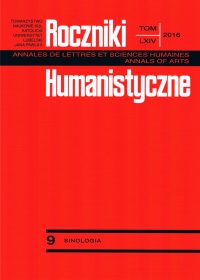Knowledge on Giant Pandas in Ancient China
Abstract
In modern times giant panda becomes an informal symbol of China, almost as popular as images of dragon, a mythical creature and heraldic animal of China till 1928. There is an astonishing contrast between today’s popularity of panda and an almost total lack of images and mentions of this animal in ancient times. Bai xiong ‘white bear,’ a local Chinese name for giant panda was registered for the first time only in 1869, by Father Armand David, who discovered giant pandas for the Europeans, the first image of panda was printed in a French zoological book in 1874, the first logo with an image of panda was created by pilots from the American Volunteer Group in Kunming (Yunnan) in 1941. If we add to this that the word xiongmao, a modern Chinese name for giant panda, is a phraseological calque from English bear cat created at the beginning of the 20th century, that panda became subject of the traditional Chinese painting in the mid of the 20th century and the literary motif of panda gained ground only after success of a popular song in 1983, we are faced with the problem of explaining, why giant panda was unknown to ancient Chinese art and literature. Some Chinese scholars assume that panda was known by other names in ancient China. Hu Jinchu enumerates a list of 25 such names, however Slovak sinologist Stanislav Vavrovský proves, that only some of them may actually mean giant panda, although the unambiguous and decisive arguments are lacking. The authors of this paper assume that giant panda was known in ancient China, however it was not differentiated as a separate species but was regarded simply as a bear (xiong). The authors present the role of bears in the mythical stories about the origin of Chinese civilization, the archaeological findings of bear bones in neolithic and bronze age tombs, as well as the images of bears in ancient Chinese art till the end of the Han dynasty. They talk through two common bear species in China: Asian black bear and brown bear, whose some subspecies are sometimes called white. The authors take notice of the fact that the known contemporary image of giant panda as a black-and-white animal is due to the discovery of the black-and-white Sichuan subspecies of this animal by Father Davis what follows that the first specimen known to Europeans became normative subspecies. However in ancient times the giant panda habitat was much more than modern refugial areas mostly in Western Sichuan mountains. The authors assume that ancient Chinese had an opportunity to meet with other pandas, e.g. from Qinling mountains, near Xi’an, a former capitol of China, than with the normative in our times subspecies of giant panda from Sichuan. The Qinling panda (Ailuropoda melanoleuca qinlingensis) is very rare in our times and having a dark brown and light brown pattern instead of „typical” black and white seems to be atypical. In ancient times because of this brownish pattern Qinling panda could not be discerned from the common brown bear. The authors assume that whenever there are images and mentions of bear in ancient Chinese art and literature, we cannot automatically exclude giant pandas.
References
Cyclopædia of India and of Eastern and Southern Asia, Commercial, Industrial and Scientific, red. Edward Balfour, vol. 3. Madras: Scottish & Adelphi Press, 1873.
Duyvendak, J.J.L. „The True Dates of the Chinese Maritime Expeditions in the Early Fifteenth Century The True Dates of the Chinese Maritime Expeditions in the Early Fifteenth Century”, T’oung Pao. Second Series, 34 (5) (1939): 402.
Edwards, Henri Milne. „Recherches pour servir à l’histoire naturelle des mammifères: comprenant des considérations sur la classification de ces animaux”. W: Alphonse Milne Edwards. Des observations sur l’hippopotame de Liberia et des études sur la faune de la Chine et du Tibet oriental. Paris 1874.
Hu Jinchu, „胡锦矗, 大熊猫的历史记载 [Historyczne relacje o pandzie wielkiej]”, Nánchōng shīyuàn xuébào (Zìrán kēxué bǎn), 1981 (3): 7–16.
Lankester, Edwin Ray. „On the Affinities of aeluropus melanoleucus”. Linnaean Society London 2.8 (1901): 163–171.
Lia Chieh-Hsin, Research on the Reflexive of Giant Panda’s Ancient Name in China, [賴皆興, 中國大熊貓古代名稱研究之反思], 2006, https://nccur.lib.nccu.edu.tw/bitstream/140.119/72509/1/7793.pdf
Psarras, Sophia-Karin. Han Material Culture. An Archaeological Analysis and Vessel Typology. Cambridge: Cambridge University Press, 2015.
Red Panda: Biology and Conservation of the First Panda, red. Angela R. Glatston. London: Elsevier, 2011.
Roberts, M. „The red panda: its history and fragile hold on the future”, Cincinnati Zoo News, Spring/Summer 1983: 1–5.
Schuessler, Axel. ABC Etymological Dictionary of Old Chinese. Honolulu: University of Hawai’i Press, 2007.
Schwendler, Louis. „On Ailurus fulgens”, Proceedings of the Asiatic Society of Bengal, 1875: 98.
Vavrovský, Stanislav. „Čínske názvy pandy veľkej”. Studia Orientalia Slovaca, 8 (2009): 163–191.
Wu Xianzhu, Zhou Guoping 2005. The animal remains from Guanzhuangping site in Hubei [武仙竹, 周国平, 湖北官庄坪遗址动物遗骸研究报告]”, Acta Anthropologica Sinica, 232–248.
Copyright (c) 2016 Roczniki Humanistyczne

This work is licensed under a Creative Commons Attribution-NonCommercial-NoDerivatives 4.0 International License.





